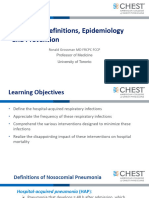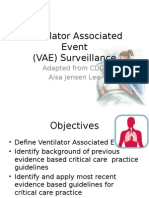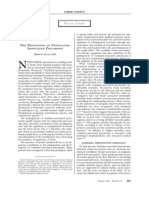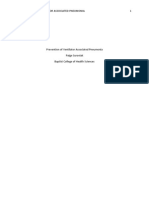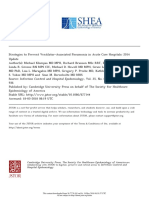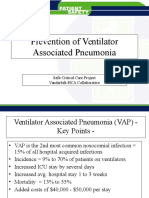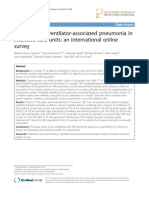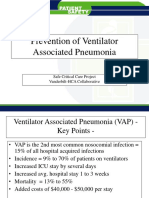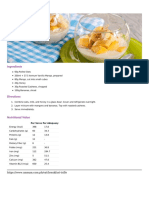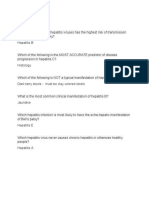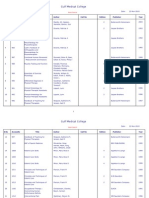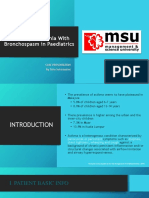DECREASING &
PREVENTING
Ventilator-Associated Pneumonia
Best Practices from JCRs HEN
ospitals participating in JCRs Partnership for Patients Hospital Engagement
Network (HEN) have experienced an overall 86% reduction in ventilatorassociated pneumonia (VAP). A ventilator-associated pneumonia is specifically
defined as a pneumonia event that occurs at the time a ventilator is in place,
or within 48 hours after a ventilator has been in place. The National
Healthcare Safety Network (NHSN) implemented new definitions for ventilator-associated events
that were effective January 2013, but the majority of the JCR HEN hospitals continue to submit
data for VAP.
The CDC definition for Ventilator Associated Events is identified by using a combination of
objective criteria: deterioration in respiratory status after a period of stability or improvement
on the ventilator, evidence of infection or inflammation, and laboratory evidence of respiratory
infection. The national goal set by the Centers for Medicare and Medicaid Services (CMS), as
part of its Partnership for Patients Initiative, is to decrease the preventable hospital-acquired event
of ventilator-associated pneumonia by 40% from baseline.
HOW DID THEY DO IT?
Most hospitals in JCRs HEN have implemented the VAP bundle, which includes:
Elevation of the head of the bed
Daily sedation vacations
Peptic Ulcer disease prophylaxis
Deep Vein Thrombosis prophylaxis
Daily oral care with Chlorhexidine
The JCR HEN has held monthly group webinar learning sessions focused on reduction of
ventilator-associated pneumonia. The group completed a SWOT analysis and developed a Cause
& Effect diagram that the hospitals use with their VAP improvement teams. There has been
extensive review of literature and protocols related to delirium avoidance, as well as early mobility
programs. Hospitals achieving and sustaining reductions have presented their story on the group
calls in order to promote sharing across all the hospitals. Achieving and sustaining reductions is
accomplished through ongoing monitoring and feedback to staff involved.
Page 1
�THE RESULT?
As a HEN, JCR has achieved an 86% reduction in ventilator-associated pneumonia from
the baseline rate:
Page 2
�The road to success has many challenges and barriers, however. Overcoming them takes hard
work and dedication, which JCR HEN hospitals have committed to and are making progress.
Some of the challenges and barriers they face include:
Obtaining ongoing leadership support
Identifying and sustaining a physician champion
Ensuring all the components of the VAP bundle
are consistently implemented
Implementing early mobility and delirium avoidance
protocols/programs
Providing ongoing staff and patient education
Effective hand-off communication
Continued use of restraints for all ventilated patients
New N.H.S.N. definitions and data collection for
ventilator-associated events
Page 3
�During monthly calls with the HEN hospitals, JCR consultants have been
FACTS ABOUT VAP
reviewing VAP data and information, providing tools and guidelines, and
VAP is one of the most common
infections acquired by adults and
children in ICUs
The VAP reductions within JCRs HEN have been outstanding, said Jodell
Reported rates of VAP range
from 1 to 4 cases per 1,000
ventilator days, but rates may
actually exceed 10 cases per
1,000
Patient mortality attributable to
VAP may exceed 10%
Risk factors for VAP include
prolonged intubation, enteral
feeding, witnessed aspiration,
paralytic agents, underlying
illness, and extremes of age
Estimated cost per infection
ranges from $14,000-$29,000
Estimated total cost of VAP
infections in the U.S. is $0.8
billion-$1.5 billion a year
Sources: The Society for
Healthcare Epidemiology of
America, Centers for Disease
Control
encouraging hospitals to share their best practice stories.
Speckhart, Consultant and Project Manager, Joint Commission Resources.
Team members are motivated and engaged, tapping into the education and
resources offered by our experts. It has truly been a partnership effort.
Some of the strategies JCR has recommended to the VAP reduction teams are:
Consistently provide feedback to staff and physicians on the
organizations ventilator-associated pneumonia rate
Have physicians participate in team meetings
Involve the respiratory therapist, physical therapist, dietary,
intensivist, and hospitalist in the team
Implement daily multidisciplinary huddles
Participate in the monthly JCR HEN VAP Affinity Group
to network with peers
Implement quiet time daily and develop a protocol
to lighten sedation
Consider oral care every two hours, alternating between
nursing and respiratory therapists
Develop and review Order Sets to ensure all components
of the bundle are addressed
Use disposable AMBU bags and consider the use of
intermittent subglottic suction catheters
JCRs work with its HEN hospitals is ongoing. But to sustain improvements,
the work will not be over when the Partnership for Patients project ends.
Reducing harm and improving the quality of care is an ongoing effort, said
Speckhart. JCR will continue to partner with hospitals, offering consulting
services and products to help reduce hospital-acquired conditions and
provide more reliable, less costly care.
Page 4




















